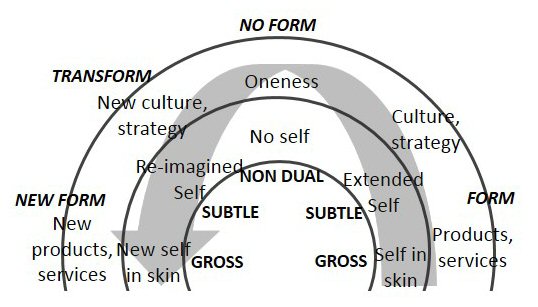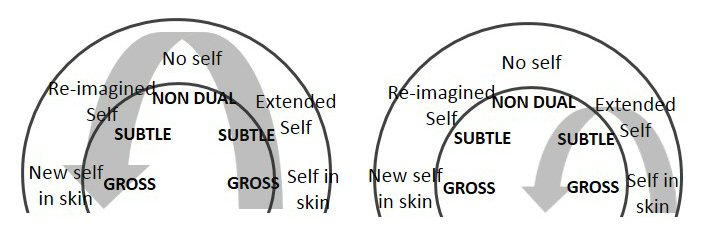zen, leadership, and the fourth turning of buddhism
Ginny Whitelaw for Integral Post: March 26th, 2014
My, has Ken Wilber opened a rich territory for us to explore! I’ve read with great interest The 4th Turning – Exploring the Future of Buddhism, and applaud his efforts to bring Buddhism up to date. His Integral frame of structural “rungs” through which we grow up, states through which we wake up, and shadow conditions where we can mess up at every turn, gives guidance to countless questions that arise in practice. Reading The Fourth Turning, the possibilities for application exploded like popcorn in my mind. I hope to tease out a few of them in this forum in the months to come. But let me start with one that is of profound importance to leaders: The U Turn.
The U Turn is a cycle of transformation through states, those states being (in their simplest construct) gross, subtle and non dual. The gross state is the sensorimotor, everyday world of matter and form. The subtle state can be thought or imagined; it passes into the realm of pure energy, soul or spirit. The non-dual world is the state of Samadhi where self and other disappear, the state of no-self, oneness, emptiness. The U Turn speaks to progressing through these states to an awakening of non-dual consciousness, and then returning through the subtle and gross realms for this experience to get enacted, or to “hammer the sensorimotor realm into shape,” as Ken colorfully describes. This hammering can take some time and many U Turns, which is the difference between awakening as a momentary “aha!” and its lived embodiment. The U Turn can be both an “I” experience and a “we” experience, both of which interest us from a leadership perspective.

Figure 1: The U Turn – A Cycle of Transformation
How might a U Turn function in leadership? If we consider a business example, the gross realm would include products and services, customers and employees, brick and mortar and so on. The subtle realm would include elements of imagination: values and culture, vision and strategy, even the future itself: ideas that may inform the gross realm, but that “I” or “we” can imagine at a meta-level. The non-dual state of Samadhi is often not called out in business, but it happens all the time: the Samadhi of complete immersion in one’s work, or the Samadhi of a high performing team clicking on all cylinders. The flow state that Mihaly Csikszentmihalyi has researched for years is a kind of Samadhi. Samadhi experiences differ in how they generalize, how long they last, and how deeply they penetrate through us. But most people have no reference point for even recognizing they had a Samadhi experience. (I’d heard about Samadhi for years before I could recognize it in my own experience through meditation). In that case, when “I” makes the U Turn and distills back out of Samadhi, it’s interpretation can be anything from “Wow, I’m a genius; I just had a great idea!” to, “That was a really good meeting; time just flew by.”
But let’s say from a state of Samadhi, insight arises: a glimpse into the future, an unmet need, a new direction for my company, a way forward on a vexing problem. This is not ordinary thought from the subtle state, which is still “I” centered and intentional. These are not answers contrived by cleverness. They are the functioning of no-self interfused with self: they are insights both of this world and not of this world. The job of the self is to get them into this world. So the leader, making the U Turn, looks at what has to change in the subtle realm. Specifically how does this insight lead to new values and behaviors? How would it change our business model or culture? Through these subtle tools, leaders are able to transform (i.e., literally change the form of) the gross realm into new products and services, new customers, new buildings and so on.

Figure 2a: Full U turn – Samadhi-based transformation
Figure 2b: Sub-orbital U turn – Ordinary “I”-based change
Being able to make the U Turn through non dual consciousness is the work of a Zen leader: a capability in all of us (see Figures 1, 2a). Here, insight or vision is informed from a connected state, where “I” and the future are not separate. But “sub-orbital” U Turns are more the norm: where we move from gross to subtle states, and back to gross (Figure 2b). We may have fine ideas, but they’re still informed by the limits of self-imagination. In a sub-orbital U Turn, we never fully escape the gravity of “I.” As individual leaders, the gross realm is “myself in my skin.” The subtle realm we can think of as our extended self and thoughts – our net of influence and caring, our range of power or compassion, our hopes and dreams for the future. We may enter this state of imagination or reflection to consider what we need to focus on, how we can solve this or that problem, whose help we need to enlist, and so on. And then we come out of this state and myself-in-my-skin acts. This is not a bad cycle to move between: action and reflection. But if we never leave the gravity of “I”, anything we do is still of this world. It doesn’t have that that wondrous, universal quality that comes only from the full U Turn.
So how do we make full U turns? The state of Samadhi cannot be willed by the self that dissolves on entering it. But the self can be a willing participant in training and conditions conducive to this state arising. Csikszentmihalyi’s research has characterized a number of contributors to the Samadhi flow state at work, including being both highly skilled and highly challenged, merging action and awareness, getting immediate feedback, and complete concentration on the task at hand. The more general way to cultivate this condition is meditation. My line of Chozen-ji Zen adds to that training in martial arts and fine arts to “hammer the sensorimotor system into shape” as Ken might say. If we engage in deep, sincere training (which you can explore further), we both grow up and wake up. The Zen leader in us emerges as the interfusion of no-self through self, where one great dance is going on and, footprint-free, these very feet are dancing.
Do we know how to find you?
If you received this from a friend and want your own monthly boost of insight and resources, let us know.
Published on Jun 26 2014
Last Updated on Feb 01 2024
By webadmin


